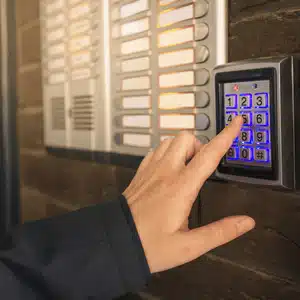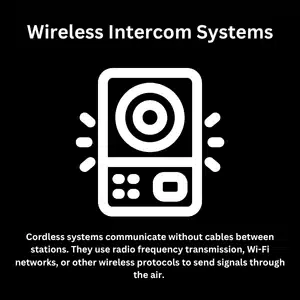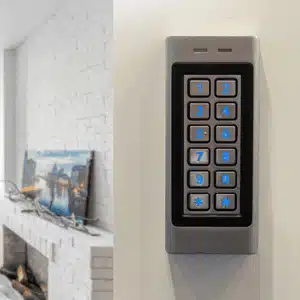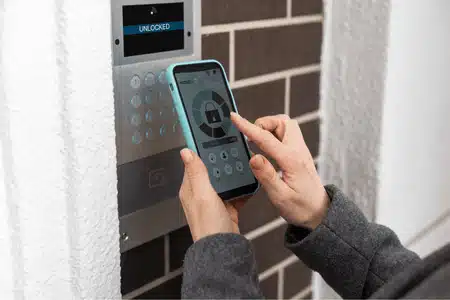Intercom systems have changed how we control access and communicate in our homes and buildings. These electronic devices let people talk to each other from different locations and control entry points like doors or gates. Modern intercom system setups do much more than the old speaking tubes from decades past.
Today’s intercoms help you screen visitors, unlock doors remotely, and stay connected throughout your property. To understand how an intercom system works, it helps to know the basic components: intercom hardware (speakers, microphones, cameras), a power supply, and a control unit. Wired or wireless connections allow for clear communication and remote door control.
Whether you’re looking at an outdoor intercom for a gated entrance or a building-wide network, there are many types of intercom to consider. Video, audio-only, wireless, and smartphone-connected systems offer different levels of convenience and security.
Other intercom systems might include paging functions or integration with home automation. Choosing the right intercom system ensures you can easily manage access and communication across your property. Whether you want to secure your home, manage an apartment building, or improve office communication, understanding types of intercom and system options will help you select the best fit. Knowing how intercom works also helps you maximize its features and ensure seamless operation.
What Is an Intercom System

An intercom system is an electronic device that facilitates communication across different rooms or areas of a building. How intercom systems work is simple: a base station—often at the main entrance—lets a visitor press a call button to contact people inside. Those inside use intercom devices or substations to respond with two-way communication.
Many modern intercom networks feature audio and video communication, letting users verify who’s at the door. The base station can unlock the door or gate remotely with a door release mechanism, enhancing security purposes. Systems often integrate with access control systems to further enhance security.
You’ll find various types of intercom setups, including wired intercom systems that use physical connections and wireless intercom systems that use radio frequencies or Wi-Fi. Wireless intercom units reduce electrical installation needs but may face interference from other wireless devices. Video intercom systems transmit video signals while also transmitting audio signals, improving property access management.
Apartment intercom systems often pair with messaging applications and smart devices for advanced features. Installing additional hardware allows for even greater system flexibility and functionality. Whether using a wired or wireless network, modern intercom setups provide clear audio or video signals throughout the property, serving both security needs and communication purposes. The base station remains a key point of control in all intercom configurations.
Audio Intercom Systems
An audio system transmits signals, providing two way communication without video. This intercommunication device works like a two-way radio, you press call, speak into the microphone, and hear the response through speakers.
Audio intercoms remain popular in homes for room-to-room use and in apartment intercom systems for entry management. Older wired intercom systems with wired system setups, often called apartment buzzers, feature a master base station at the building’s entrance and intercom units in apartments. Residents can remotely unlock doors after voice confirmation using a door release mechanism.
Though video intercom systems have surpassed audio intercom network in many modern intercom systems, audio remains a simple, budget-friendly option for facilitate communication and enhance security. It provides basic property access control when video comms isn’t required.
For installation, wired intercom setups use low-voltage cabling throughout the building, ideal during construction. Wireless systems with wireless gadgets avoid electrical installation, making them easier for retrofits but subject to external interference from other wireless devices.
Businesses use audio intercoms for front-desk paging or office messaging, while families use them for monitoring different rooms. Despite the rise of video intercom and advanced features via messaging applications, audio intercoms remain valuable for simple communication purposes and security needs.
Video Intercom Systems

Video intercom systems combine video and audio communication for enhanced security. These state-of-the-art intercom systems work like an audio intercom system but include cameras at the outdoor intercom station and screens or messaging applications indoors. When a visitor presses the call button, residents see live video signals and hear signals, improving property access decisions.
The video intercom camera provides a wide-angle view. Indoor intercom devices include wall-mounted intercom units or smartphones. Cordless intercom systems send digital signals via Wi-Fi, while cabled intercom systems use Ethernet cables to avoid interference. Visual confirmation allows users to unlock the door remotely after viewing the visitor.
Key features of this type of intercom systems include night vision, recording calls, and advanced features like remote access via phone. Intercom systems often use video intercoms to manage building’s entry securely. The master base station houses the camera, door release, speaker, and mic.
Video intercom facilitate communication and enhance security, especially in apartment buildings. Integration with access control systems adds another layer of protection. Visual communication requires more bandwidth than sound intercom systems, so wired intercom installations or strong Wi-Fi are crucial for reliable performance.
Choosing the right intercom system depends on your security requirements, building type, and budget. Whether using cabled system setups or wireless gadgets, visual intercom systems significantly improve visitor management compared to sound intercom systems. They offer a modern, flexible solution that supports remotely unlock functionality, making intercom systems smarter than ever.
Wired Intercom Systems
Intercom systems that are wired connect stations using physical cables throughout the building. Every master station and substation links through dedicated wiring, which might include simple voice wires, multi-core cables for power and signals, or ethernet cables for modern systems.
Cabled intercom systems offer significant advantages in reliability, security, and performance. Physical connections eliminate concerns about wireless range or radio interference. Communication stays consistent regardless of distance between stations. The closed wired circuit makes it much harder for intruders to intercept or hack signals.
In wired setups, stations connect through cables to central hubs or directly to main stations. Older homes might have room-to-room wiring behind walls. Apartment and office buildings often feature extensive wiring from lobby panels to each unit or office.
Modern wired systems use structured cabling like ethernet that carries both data and power. Power over Ethernet technology means one cable can supply everything needed for intercom operation. This creates a dedicated network just for intercom communication with minimal delay and excellent audio quality.
The biggest benefit is stability. Walls or long distances that block wireless signals have no effect on wires. You can connect gates at property ends to houses or link multiple building floors without signal loss concerns. Wired connections resist interference from other electrical devices.
Security is another major advantage. Intercepting hardwired connections requires physical access, making them much more secure than wireless signals. Cabled intercom systems typically provide clearer audio and video quality since bandwidth isn’t limited by wireless channels.
The main drawback is installation complexity. Running cables through walls and ceilings requires significant labor, especially in existing buildings. The best time for wired installation is during construction when walls are open and cables can be laid easily.
Retrofitting wired systems into finished buildings often involves drilling, cutting drywall, and patching, which adds expense and disruption. Many homeowners without existing intercom wiring choose wireless solutions to avoid this work.
However, if you’re building new or doing major renovations, installing intercom wiring provides long-term reliability. Once wires are in place, intercom systems can last many years with minimal maintenance issues.
Wireless Intercom Systems

Cordless systems communicate without cables between stations. They use radio frequency transmission, Wi-Fi networks, or other wireless protocols to send signals through the air. The main appeal is easy installation and flexibility without drilling holes or running wires.
Simple cordless intercoms work like walkie-talkies, using radio frequencies to communicate within certain ranges. More advanced systems connect to Wi-Fi networks, sending calls over the internet. Some systems use smartphones as substations, receiving notifications through apps.
The clear advantage is simplicity and flexibility. Installation typically involves mounting units and providing power without tearing open walls. This saves significant installation costs and time. Wireless systems are easily expandable by adding handsets or connecting mobile devices without pulling new wires.
Modern wireless intercom systems often integrate with smart home platforms and include features like mobile apps, cloud recording, and voice assistant support. Using smartphones as intercom substations lets you receive calls and unlock doors remotely from anywhere.
However, cordless systems can be less reliable than wired ones. Radio signals have limited range and can be blocked by walls or interference from other wireless devices. Large properties or thick concrete walls might need signal boosters or repeaters for full coverage.
Wireless signals without encryption could potentially be intercepted or jammed by external interference. Choose systems with secure encryption protocols to prevent eavesdropping and minimize interference from other electronic gadgets.
Wi-Fi based systems depend on your network and internet connection. Power outages or network problems could disable wireless intercoms temporarily unless you have backup power and offline capabilities. Some advanced systems require cloud subscriptions for full functionality.
Installation remains straightforward: mount devices and supply power. Door units might use batteries or connect to doorbell transformers. Test signal strength at intended locations before permanent installation to ensure proper coverage throughout your property.
Wireless intercoms work well for existing buildings where new wiring would be impractical. They’re also great for renters who can’t modify properties permanently. Businesses in temporary locations or anyone needing portable communication can deploy wireless units quickly.
Apartment Intercom Systems

Apartment intercom systems serve multifamily residential buildings where one entrance panel connects to dozens or hundreds of individual units. These systems manage visitor access for multiple residents in a secure and organized way.
The entrance panel includes a directory of residents or keypad for dialing specific units. Visitors select names from lists or enter unit numbers to initiate calls. The system then signals the corresponding substation in the resident’s apartment. Residents can talk to visitors and remotely unlock building doors if appropriate.
Older apartment intercoms used cabled systems with cables connecting every apartment to lobby panels. Some integrated with building phone lines as buzzer systems where apartment phones rang when someone buzzed from downstairs. These telephone-based systems used existing wiring for intercom communication.
Modern apartment systems increasingly use internet connections. Lobby panels connect online and call residents through apps or regular phone calls when visitors arrive. This smart approach means apartments don’t need dedicated hardware, saving installation costs and complexity.
Many current systems let residents use smartphones as intercom substations. They receive video or audio calls wherever they are and can grant access by tapping their phones. Traditional in-unit stations like wall-mounted handsets remain common in legacy systems.
The master station at building entrances includes directories, speakers, microphones, cameras for video systems, and door unlock controls. These robust panels withstand weather and heavy use. Substations in apartments can be simple audio phones or video monitors for visual verification.
Apartment intercoms greatly enhance building security by keeping doors locked while allowing authorized visitor access. Residents can screen visitors without leaving their units. Video systems add extra security by showing who’s at the door before opening.
Modern systems often log entries and take visitor photos. Some integrate with access control systems to track whose codes opened doors. Property managers can update directories remotely when tenants move and set backup numbers for unanswered calls.
Installation varies by system type. Traditional wired installations require extensive cabling to every unit. During new construction, this wiring is standard practice. Retrofit upgrades can sometimes use existing telephone lines or building networks.
Internet-based systems might only need power and network connections at entrance panels, using cloud services to reach tenants. This simplifies installation compared to wiring every apartment unit separately.
Choosing Your Intercom System
Selecting the right intercom system depends on your property type, security needs, and installation preferences. Consider whether you need basic audio communication or video verification capabilities. Think about your building’s wiring situation and whether wireless or wired installation works better.
For single-family homes, video doorbells or wireless systems often provide adequate security and convenience. Businesses with multiple offices might benefit from wired systems for reliability. Apartment buildings typically require specialized multi-unit systems with directory capabilities.
Integration with smart home systems can enhance functionality. Many intercoms connect with smart locks, security cameras, and mobile devices for complete access control. This creates seamless security setups that you can monitor and control remotely.
Consider features like night vision, recording capabilities, smartphone integration, and backup power options. Advanced systems might include voice recognition, automatic unlocking for recognized visitors, or integration with messaging apps for added communication options.
Professional installation often helps with complex systems, especially wired or multi-unit installations. Experienced integrators can recommend appropriate systems and handle technical setup properly. They ensure proper placement for optimal coverage and functionality.
Modern intercom systems provide security, convenience, and efficient communication for many scenarios. Whether you choose audio or video, wired or wireless, the right system will help you control property access and communicate effectively with visitors and residents.
A well-chosen intercom increases security by enabling safe visitor screening and remote access control. You’ll know who’s at your door and can interact with them safely, often even when you’re not on-site. This peace of mind makes intercoms valuable additions to any property.


